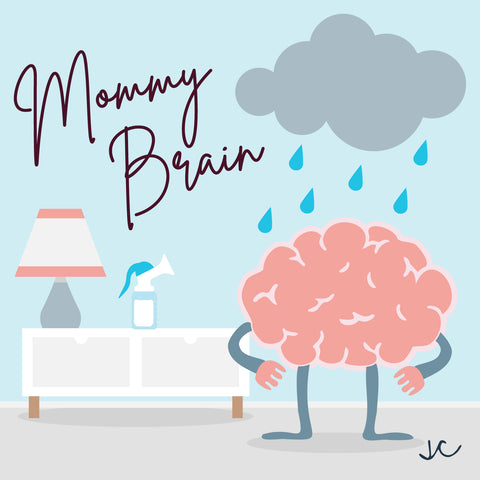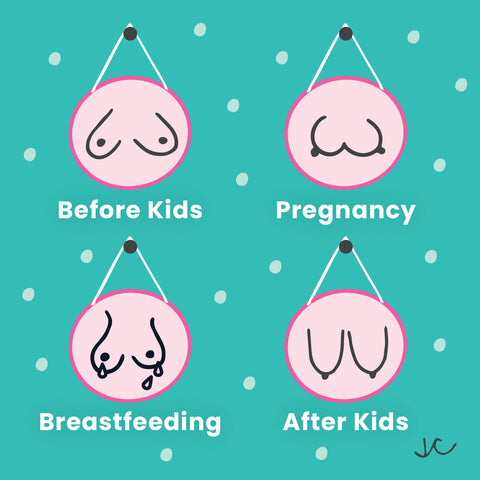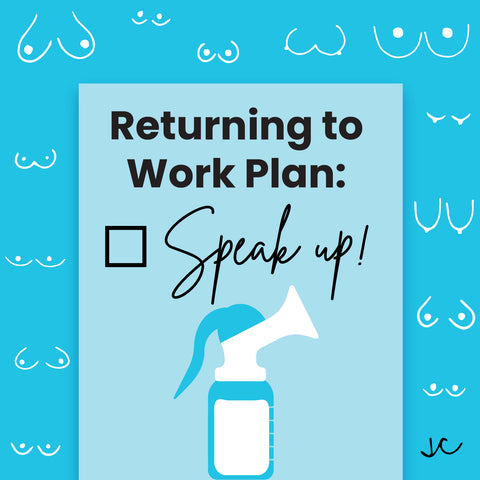Postpartum Body Changes: Embrace Your Postpartum Glow-Up

Estimated read time: 12 minutes
Read on for everything you need to know about postpartum body changes
We already know that the postpartum journey is a rollercoaster of emotions and changes. You’re incredible body has just created and birthed an adorable, tiny little person, and you should be so proud of yourself mama.
But after birth comes a new life and, in some ways, a new you. The postpartum body changes are different for every woman, and body changes after childbirth can be something some mamas find difficult to deal with.
Don’t worry Breastie. You were gorgeous before having a baby and you are gorgeous now. But if you’re feeling a little anxious about your postpartum body changes, and postpartum body recovery, fear not. We’re here to give you the lowdown about what to expect after giving birth. We are here to help as you are embracing your postpartum transformation.
You’ve got this. Now let's get to your postpartum glow-up!
In this article:
- Body changes after birth
- Uterus contractions
- Why do I still look pregnant
- Diastasis recti
- Vaginal discharge
- Nigh sweats
- Bigger, harder (more beautiful) Boobies
- Breast changes
- Hair loss
- Urinary incontinence
- Constipation
- Pimples
- Postpartum body changes: When to call the doctor
This website uses affiliate links which may earn a small commission on purchases made at no additional cost to you.
Body changes after childbirth
Our amazing bodies go through a whole heap of changes during pregnancy. And it’s no surprise. After all, we’re creating life in there! From hormonal changes and swelling to taste and smell changes to circulatory changes, pregnancy can do a number on your body.
But what about body changes after childbirth?
Of course, when you’re pregnant, even though you might Google every weird and wonderful pregnancy symptom, you can always ask your midwife or OB/GYN about them. After giving birth, however, many women feel on their own and might struggle to find the answers they’re looking for. This can lead to panic. Am I meant to look like this? Do my Boobs look normal? Is my period supposed to be this heavy?!
Sister, we get it.
There will be changes in your body after giving birth. Your body will inevitably look different after giving birth, especially as the body changes you experienced during pregnancy don’t just magically disappear as soon as your little one arrives.
So, let’s look at some of those postpartum body changes you might experience.
1. Ouch! Uterus contractions
Yep. These don’t always end after giving birth. Postpartum uterus contractions are real. So let's give you an understanding of uterus changes. Your uterus grows to accommodate your baby, and once you’re not pregnant, it has to shrink back down to its pre-pregnancy size. This causes it to contract. These contractions can feel like period cramps but for some, it can feel just as painful as labor contractions, especially if you breastfeed.
This is totally normal and the good news is these contractions settle down pretty quickly and tend to last just a few days. If the pain is really bad though you should always speak with your doctor.
2. Why do I still look pregnant?
Mama, it took nine months to make your gorgeous baby, and as much as we’d love to fit back in our pre-pregnancy jeans, that adorable little bump will take some time to go down. Just like pregnancy, you will likely experience another body transformation postpartum.
We shouldn’t expect our bodies to “bounce back” immediately after giving birth (thanks Hollywood), as the uterus and all those extra fluids need time to gradually decrease. You should never feel pressured to look like those celebrities who seem to get their bodies back straight away. They have personal trainers, nannies, and nutritionists to get them looking like that, and concentrating on your wellness and your baby is far more important. Body transformation postpartum takes time, after all, you did just create a freaking human for nearly 10 months!
3. Diastasis recti
Have you heard of diastasis recti after pregnancy?
This is also known as separated stomach muscles, this is when the two muscles that run down the middle of your pretty tummy separate during pregnancy. This usually happens because your uterus pushes the muscles apart, making them longer and weaker.
While the muscles tend to go back to normal after a couple of months, sometimes they need a little help. A physiotherapist can help by giving you special exercises such as pelvic floor exercises for managing abdominal separation postpartum and healing diastasis recti.
4. Vaginal discharge
Postpartum vaginal discharge is known as lochia, and it can kinda resemble a heavy period. Lochia is the leftover blood, mucus, and tissue from your pregnancy, and you’ll have it whether you gave birth vaginally or via C-section. Not to worry, this is normal vaginal change after birth.
While coping with postpartum discharge, you should always avoid tampons as they can put you at risk of infection, and use those hefty maternity pads instead.
5. Night sweats
Nope, it’s not the menopause. Have you heard of nigh sweats after giving birth?
One icky postpartum body change is night sweats. You might wake up soaking wet for the first couple of weeks after giving birth, and while it isn’t fun, it’s a normal bodily change.
Once your placenta is delivered, your estrogen and progesterone levels drop. Estrogen is believed to play a part in the thermoregulatory center of the brain - think of it as your internal thermostat. Having such a drastic decrease in estrogen can result in these hot flashes, which most mamas experience while sleeping.
Coping with postpartum night sweats can be frustrating. There isn't much that you can do for managing sweating postpartum, so embrace this postpartum transformation. This is just another part of your postpartum glow-up.
6. Bigger, harder (more beautiful) Boobies
We are talking about postpartum breast changes. Oh, that moment when your milk comes in. For the first few days after giving birth your Boobies will produce your baby’s first food - colostrum. A densely nutritious fluid that provides all the goodness they need.
Fast forward a couple of days and your Boobs will get larger and your breast tissue will get harder as your milk is produced and collected in the breast tissue. You might wake up one morning leaking and feeling like you have boulders on your chest! This can be uncomfortable as your magical Boobs adjust to their new job.
7. Breast changes
Our breasts are amazing, and it’s completely normal for them to sag and change in size and shape after pregnancy. Some women even have changes to the color of their nipples and areolas during pregnancy that become permanent after giving birth.
At Titty City Design, we support embracing changes in breast size and breast changes postpartum. Remember, every Titty is pretty and it’s natural for breasts to change at different stages of life. Make sure you get yourself fitted for a bra that fits and supports you, whether you breastfeed or not.
8. Hair loss
This is one that we could really do without. Yup. Postpartum hair loss. Not many people talk about this one, but honestly, we should! So we are here to help warn you about postpartum hair shedding.
Because of the change in hormones during pregnancy, women shed a lot less hair (it’s normal to shed around 100 hairs a day). As a result, while you were pregnant you might have experienced extra thick, lush, and full hair.
Once you’ve given birth, your hair will start to shed again, and you might notice a lot of the excess hair you had while pregnant suddenly fall out. Hair is a big deal and coping with hair changes after pregnancy can be hard.
While this can be shocking and upsetting for some reason, postpartum hair loss is normal. Research shows it usually happens around two to four months after giving birth, and while it can be upsetting, it is usually temporary.
If you feel like it’s affecting your self-confidence, or your hair loss isn’t improving, speak to your doctor.
9. Urinary incontinence
Quick! Where’s the restroom? Towards the end of your pregnancy, the weight of your beautiful baby can put a strain on your pelvic floor muscles. These muscles help support your bladder control, and if they weaken, it can cause you to leak a little bit of pee when you sneeze, cough, laugh, or lift.
Oh, the joys of being a mother! Postpartum urinary incontinence is just another possibility of your postpartum glow-up.
In coping with bladder changes after birth and managing postpartum incontinence it is a good idea to practice kegel exercises. This will help to strengthen your pelvic floor muscles, since after giving birth, these muscles will still be weak. You can do these exercises throughout the day as soon as you’ve given birth.
10. Constipation
You can’t stop going number one, but you’re straining to go number two! Welcome to postpartum constipation mama, another lovely postpartum body change.
Now, don’t worry, this is normally something that only lasts for the first few days after birth. In fact, it can take up to three days to poop thanks to all those painkillers, weakened ab muscles, and the trauma of delivery. A lot of moms also worry they’re going to rip any stitches they might have been given during delivery.
It’s important to keep things moving. We're talking about your bowels. To help manage postpartum bowel issues drink at least eight glasses of water a day (btw, our Titty Tumbler is amazing for this) and eat lots of fruit, veggies, and fiber-rich foods to help with digestive changes after birth.
11. Pimples
Remember that gorgeous pregnancy glow? Well, the hormones that made your skin look flawless throughout pregnancy take a nose-dive after giving birth, and it’s pretty common to develop acne. You might even notice your baby gets some lil’ pimples too, as they have the same hormones. Postpartum acne can be a bummer as your skin changes after pregnancy.
As much as zits suck, they usually clear up after a month or two, but if they’re causing you grief, speak to your doctor about a suitable acne cream to speed the process up a bit in managing postpartum pimples.
Postpartum body changes: When to call the doctor
Ok, so it is important to know when to seek medical advice. While all of these changes, and a number of others, are normal after giving birth, it’s helpful to know what’s natural and when it might be time to call your doctor.
There are some signs to call the doctor after giving birth. Make sure you are seeking medical help for postpartum changes if you experience any of these changes during the first six weeks after giving birth, play it safe and make the call:
- A fever of 100.5 degrees or higher
- Severe pain, discharge, or redness from a C-section or episiotomy scar
- Sudden heavy bleeding or very large clots. You’ll know it’s heavy if you soak a pad every half hour or so
- Nausea or vomiting
- Fainting
- Constipation that lasts longer than three days
- Foul-smelling vaginal discharge
- Continuous bad headaches
- Vision changes
- Redness, swelling, or pain in your breasts
- A swollen, tender, or red patch in your leg or calf
- Strong feelings of sadness, anxiety, or depression that last longer than a few days
There are other warning signs to look out for, and the CDC lists them here.
Your postpartum body is beautiful mama
We understand that some of these changes might be difficult to get your head around, but just remember what you’ve done. Your body has created and birthed life. Your body has nourished that life for nine months and continues to do so now (if you’re breastfeeding).
Your body is amazing. YOU are amazing. Embrace your postpartum glow-up.
And while most postpartum body changes are temporary, you should feel proud of how your body looks. You’re a warrior and your postpartum glow-up is fabulous mama.
And we’re so proud of you.
At Titty City Design, we believe that every boobie is beautiful, and that should be celebrated. We are a female-owned and operated, small business here to spread self-love and body positivity with our line of boob apparel, boob accessories, and boob-themed decor and products for the home. A portion of our proceeds goes to help support postpartum people and breast cancer patients.
Unique Gifts for New Moms They Will Love





















